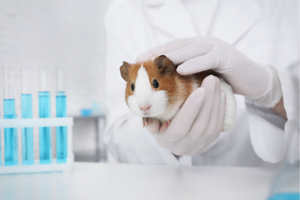Prior to obtaining a marketing authorisation, every new cosmetic goes through the experimental stage. Laboratory tests are aimed at verifying that the product would not harm consumers. In our article, we will look for answers to the following questions: What is animal testing?, Is it legal and how is it conducted?

What does the term of “animal testing” mean?
“Guinea pig”, a commonly used term, evokes negative associations. It refers to experiments carried out on vulnerable animals that are unaware of the dangers. “Animal testing” invites equally pejorative opinions. The term means that some animal species (mammals, birds or amphibians) are used for specified scientific or research purposes. Animal testing is conducted both in the cosmetic industry and in other branches such as the pharmaceutical, medical, biochemical and chemical industries.
If products are tested on animals as a prolonged and repeated activity, it usually involves the following:
- the need to keep individual animals from each species in isolation,
- the discomfort and suffering of the animals,
- a high probability that the tested animals will lose their health or life.
In the 20th and 19th centuries, cosmetic companies that entered the market would extensively use animals. At present, we witness major changes in the philosophy of animal protection regarding their presence in test laboratories.
How do Polish and EU laws regulate the testing of products on animals?
Testing of cosmetics on animals in the light of the law
There is an ongoing quest for alternative and safe methods to test cosmetic products and their ingredients. Poland and the European Union have entirely banned testing cosmetics on animals. For laws regulating the issues of animal protection, see e.g.:
- the amended Act of 15 January 2015 on the protection of animals used for scientific or education purposes,
- Directive 2010/63/EU of the European Parliament and of the Council of 22 September 2010 on the protection of animals used for scientific purposes and
- Communication from the Commission to the European Parliament and the Council on the animal testing ban of 2013.
In Europe, it is forbidden to sell or distribute cosmetics that have been tested on animals. High penalties also apply to dishonest manufacturers or importers who attempt to market prohibited ingredients.
Based on the figures shared by the Polish Union of the Cosmetics Industry, over 40 countries all over the world have established legal regulations to ban the trade of cosmetics tested on animals.

What is the Cruelty-Free certificate?
In order to provide labelling for safe and legal cosmetics, the US organisation PETA (People for the Ethical Treatment of Animals) has introduced the Cruelty-Free certification.
A certificate with a characteristic bunny symbol is given to those companies that have undergone a stringent quality control and proven their products are not tested on animals. The certificate is valid all over the world – it can be given to any company which complies with law and ethical rules concerning the treatment of animals.
On which animals are cosmetics tested?
Cosmetic labs in the world use specific animal species. On which species are cosmetics most frequently tested? The most commonly chosen animals include:
- mice and rats,
- cats,
- dogs and
- guinea pigs.
In some countries, such as China or the United States of America, it is still very popular to test cosmetics on rabbits. Despite numerous information campaigns and efforts to change the law, primates are also used in experiments by international cosmetic companies.
What cosmetics are most frequently tested on animals?
Few people are aware how cosmetic testing is carried out. Laboratories all over the world treat vulnerable creatures in an inhumane manner. Animals are usually used to test and evaluate:
- the effect of different preparations (creams, gels, perfumes, soaps, shampoos etc.) on the skin and mucosa of animals and
- the probability of allergic reactions, diseases and other conditions following the contact with a cosmetic.
During lab experiments, animals are immobilised or kept in cages, causing their discomfort, stress and even chronic diseases and death.

Why is testing cosmetics on animals controversial?
There is no doubt that animals that cosmetics have been tested on are no longer fully healthy. The contact with new and unknown substances causes hair loss, pain, skin lesions, loss of appetite and apathy. Prolonged contact with chemical mixtures, creams, gels and antiperspirants causes chronic illnesses in some animals. Artificial ingredients applied to their skin on and off make animals kept in labs lose their health irrecoverably.
As the consumers’ awareness grows, people become much more interest in the fate of animals and how they are treated in laboratories. People ask increasingly what role living creatures play in the production of cosmetics and to what extent it is legitimate to use them. The animal testing procedure arouses controversy all over the world. Even the greatest cosmetic brands of an international coverage abandon animal testing and opt for new and innovative technologies.
Testing of cosmetics on animals: pros and cons
Despite the ban on cosmetic animal testing applicable in the European Union, medical and pharmaceutical companies use experiments on a great scale. Many scientists believe that animal testing is the only effective method to evaluate the quality and safety of different products and their ingredients. This position is mostly due to the fact that we, the humankind, have not yet developed any alternative tests for cosmetics, drugs etc. that would be equally effective.
Opponents of animals testing resort to ethical issues. In their opinion, people have no right to endanger the health and life of other species of living creatures for their own interests. The major issue that gives rise to objections is the use of animals in cosmetic labs. Can the production and sale of cosmetics be conducted at the cost of animals suffering? We should ask this question to ourselves when reaching for another trendy cosmetic or dietary supplement.
- https://ec.europa.eu/commission/presscorner/detail/pl/IP_13_210
- https://www.humanesociety.org/resources/cosmetics-animal-testing-faq